A Bibliometric Analysis of Wearable Device Research Trends 2001–2022—A Study on the Reversal of Number of Publications and Research Trends in China and the USA
Abstract
:1. Introduction
2. Methods
2.1. Bibliometric Analysis
2.2. Cluster Analysis
2.3. Co-Occurrence Analysis of Keywords
- Degree Centrality
- 2.
- Betweenness Centrality
- 3.
- Closeness centrality
- Type of analysis: Co-occurrence
- Unit of analysis: All keywords
2.4. Data Collection
2.5. The Software Used for the Analysis
3. Results
3.1. Characteristics of Research Domains
3.2. Co-Occurrence Analysis of Keywords
3.3. Comparing Two Countries’ Contributions to the Research Domains (China vs. USA)
4. Discussion
5. Conclusions
6. Limitations
Author Contributions
Funding
Institutional Review Board Statement
Informed Consent Statement
Conflicts of Interest
Appendix A
Appendix A.1
| Abbreviation | Description |
|---|---|
| AB | Abstract |
| AF | Author’s full name |
| AU | Author’s name |
| BP | Beginning page |
| BS | Series Subtitle |
| C1 | Author Affiliation |
| CR | Works Cited |
| DA | Date this report was generated (exported) |
| DE | Author Keywords |
| DI | Digital Object Identifier (DOI) |
| DT | Document type |
| EM | Email address |
| EP | End page |
| ER | Identifier indicating the end of the record |
| FN | File name |
| GA | Document Delivery Number |
| IS | Issue |
| J9 | 29-character abbreviated form of publication name |
| JI | ISO publication name abbreviated form |
| LA | Language |
| NR | Number of references cited |
| PA | Publisher’s address |
| PD | Date of issue (month) |
| PG | page number |
| PI | Place of Publication |
| PT | Publication type (J=Journal; B=Book; S=Series; P=Patent) |
| PU | Publisher |
| PY | Publication year |
| RP | Reprint request address |
| SC | Research Field |
| SN | International Standard Serial Number (ISSN) |
| SO | Publication name |
| TC | Number of citations in the Web of Science Core Collection |
| TI | Document title |
| U1 | Number of times used (last 180 days) |
| U2 | Number of times used (since 2013) |
| UT | Accession Number |
| VL | Volume |
| VR | Version number |
| WC | Web of Science field |
| WE | Type of Citation Index |
| Z9 | Total number of citations |
Appendix A.2
| Year | China | USA | ||
|---|---|---|---|---|
| Publication | Citation Impact | Publication | Citation Impact | |
| 2001 | - | - | 13 | 97.15 |
| 2002 | - | - | 6 | 29.17 |
| 2003 | - | - | 14 | 44.64 |
| 2004 | 1 | 2.00 | 11 | 63.64 |
| 2005 | 2 | 11.50 | 12 | 42.67 |
| 2006 | 2 | 16.00 | 13 | 35.15 |
| 2007 | 1 | 12.00 | 13 | 209.85 |
| 2008 | 3 | 18.33 | 20 | 73.85 |
| 2009 | 2 | 20.00 | 18 | 28.17 |
| 2010 | 8 | 170.25 | 32 | 186.66 |
| 2011 | 11 | 83.18 | 33 | 75.82 |
| 2012 | 11 | 146.73 | 41 | 63.98 |
| 2013 | 33 | 89.55 | 55 | 119.40 |
| 2014 | 86 | 139.58 | 74 | 112.65 |
| 2015 | 171 | 86.64 | 178 | 89.58 |
| 2016 | 309 | 75.89 | 296 | 73.36 |
| 2017 | 563 | 59.53 | 454 | 57.63 |
| 2018 | 852 | 45.57 | 539 | 40.67 |
| 2019 | 1209 | 31.81 | 746 | 26.13 |
| 2020 | 1500 | 19.44 | 826 | 15.21 |
| 2021 | 1974 | 5.96 | 866 | 4.61 |
Appendix A.3
| Degree Centrality | Betweenness Centrality | Closeness Centrality | ||||||
|---|---|---|---|---|---|---|---|---|
| Rank | Score | Country | Rank | Score | Country | Rank | Score | Country |
| 1 | 68 | USA | 1 | 207.78 | USA | 1 | 0.01042 | USA |
| 2 | 66 | China | 2 | 166.06 | Italy | 2 | 0.01020 | China |
| 3 | 65 | England | 3 | 159.53 | England | 3 | 0.01010 | England |
| 4 | 59 | Italy | 4 | 152.16 | Spain | 4 | 0.00952 | Italy |
| 5 | 59 | Spain | 5 | 146.70 | China | 5 | 0.00952 | Spain |
| 6 | 58 | Germany | 6 | 105.94 | France | 6 | 0.00943 | Germany |
| 7 | 57 | France | 7 | 89.85 | South Korea | 7 | 0.00935 | France |
| 8 | 57 | India | 8 | 88.59 | Germany | 8 | 0.00935 | India |
| 9 | 56 | South Korea | 9 | 86.97 | Saudi Arabia | 9 | 0.00926 | South Korea |
| 10 | 54 | Saudi Arabia | 10 | 86.45 | India | 10 | 0.00909 | Saudi Arabia |
Appendix A.4
| Country | Author | Title | Source | Year | Number of Citation | References |
|---|---|---|---|---|---|---|
| China | Ling, Zheng et al. | Flexible and conductive MXene films and nanocomposites with high capacitance | Proceedings of the National Academy of Sciences of the United States of America, 111(47), 16676–16681 | 2014 | 1118 | [60] |
| Meng, Chuizhou et al. | Highly Flexible and All-Solid-State Paper like Polymer Supercapacitors | Nano Letters, 10(10), 4025–4031 | 2010 | 998 | [61] | |
| Wang, XW; Gu, Y; Zhang, T | Silk-Molded Flexible, Ultrasensitive, and Highly Stable Electronic Skin for Monitoring Human Physiological Signals | Advanced Materials, 26(9), 1336–1342 | 2014 | 982 | [62] | |
| Kou, Liang et al. | Coaxial wet-spun yarn supercapacitors for high-energy density and safe wearable electronics | Nature Communications, 5, 3754 | 2014 | 856 | [63] | |
| Pu, Xiong et al. | Ultrastretchable, transparent triboelectric nanogenerator as electronic skin for biomechanical energy harvesting and tactile sensing | Science Advances, 3(5), e1700015 | 2017 | 696 | [64] | |
| Meng, Fanlu et al. | In Situ Coupling of Strung Co4N and Intertwined N-C Fibers toward Free-Standing Bifunctional Cathode for Robust, Efficient, and Flexible Zn Air-Batteries | Journal of the American Chemical Society, 138(32), 10226–10231 | 2016 | 674 | [65] | |
| Pelaz, Beatriz et al. | Diverse Applications of Nanomedicine | ACS Nano, 11(3), 2313–2381 | 2017 | 655 | [66] | |
| Koh, Ahyeon et al. | A soft, wearable microfluidic device for the capture, storage, and colorimetric sensing of sweat | Science Translational Medicine, 8(366), 366ral65 | 2016 | 612 | [67] | |
| Pu, Xiong et al. | Wearable Self-Charging Power Textile Based on Flexible Yarn Supercapacitors and Fabric Nanogenerators | Advanced Materials, 28(1), 98 | 2016 | 572 | [68] | |
| Lei, Zhouyue et al. | A Bioinspired Mineral Hydrogel as a Self-Healable, Mechanically Adaptable Ionic Skin for Highly Sensitive Pressure Sensing | Advanced Materials, 29(22), 1700321 | 2017 | 572 | [69] | |
| USA | Gao, Wei et al. | Fully integrated wearable sensor arrays for multiplexed in situ perspiration analysis | Nature, 529(7587), 509 | 2016 | 2367 | [7] |
| Lara, Oscar D. and Labrador, Miguel A. | A Survey on Human Activity Recognition using Wearable Sensors | IEE Communications Surveys and Tutorials, 15(3), 1192–1209 | 2013 | 1308 | [70] | |
| Hu, Liangbing et al. | Stretchable, Porous, and Conductive Energy Textiles | Nano Letters, 10(2), 708–714 | 2010 | 1244 | [71] | |
| Pantelopoulos, Alexandros and Bourbakis, Nikolaos G. | A Survey on Wearable Sensor-Based Systems for Health Monitoring and Prognosis | IEEE Transactions on Systems Man and Cybernetics Part C-Applications and Reviews, 40(1), 1–12 | 2010 | 1233 | [53] | |
| Ling, Zheng et al. | Flexible and conductive MXene films and nanocomposites with high capacitance | Proceedings of the National Academy of Sciences of the United States of America, 111(47), 16676–16681 | 2014 | 1147 | [60] | |
| Son, Donghee et al. | Multifunctional wearable devices for diagnosis and therapy of movement disorders | Nature Nanotechnology, 9(5), 397–404 | 2014 | 998 | [54] | |
| Lee, Hyunjae | A graphene-based electrochemical device with thermoresponsive microneedles for diabetes monitoring and therapy | Nature Nanotechnology, 11(6), 566 | 2016 | 970 | [72] | |
| Shin, Seong Sik et al. | Colloidally prepared La-doped BaSnO3 electrodes for efficient, photostable perovskite solar cells | Science, 356(6334), 167–171 | 2017 | 820 | [73] | |
| Dickey, Michael D. | Stretchable and Soft Electronics using Liquid Metals | Advanced Materials, 29(27), 1606425 | 2017 | 795 | [74] | |
| McAlpine, Michael C. | Highly ordered nanowire arrays on plastic substrates for ultrasensitive flexible chemical sensors | Nature Materials, 6(5), 379–384 | 2007 | 789 | [75] |
References
- Ometov, A.; Shubina, V.; Klus, L.; Skibińska, J.; Saafi, S.; Pascacio, P.; Flueratoru, L.; Gaibor, D.Q.; Chukhno, N.; Chukhno, O.; et al. A survey on wearable technology: History, state-of-the-art and current challenges. Comput. Netw. 2021, 193, 108074. [Google Scholar] [CrossRef]
- Mordor Intelligence, GROWTH: Smart Wearable Market, Trends COVID-19 Impact, and Forecasts (2022–2027). Available online: https://www.mordorintelligence.com/industry-reports/smart-wearables-market (accessed on 10 October 2022).
- International Data Corporation. Worldwide Quarterly Wearable Device Tracker. Volume 2022. Available online: https://www.idc.com/getdoc.jsp?containerId=IDC_P31315 (accessed on 10 October 2022).
- Reportlinker.com. Global Wearable Technology Market 2022–2026. Available online: https://www.reportlinker.com/p05849727/Global-Wearable-Technology-Market.html (accessed on 10 October 2022).
- Vandrico. The Wearable Database. Available online: https://vandrico.com/wearables.html (accessed on 10 October 2022).
- Katori, M.; Shi, S.; Ode, K.L.; Tomita, Y. The 103,200-arm acceleration dataset in the UK Biobank revealed a landscape of human sleep phenotypes. Proc. Natl. Acad. Sci. USA 2022, 119, e2116729119. [Google Scholar] [CrossRef]
- Gao, W.; Emaminejad, S.; Nyein, H.Y.Y.; Challa, S.; Chen, K.; Peck, A.; Fahad, H.M.; Ota, H.; Shiraki, H.; Kiriya, D.; et al. Fully integrated wearable sensor arrays for multiplexed in situ perspiration analysis. Nature 2016, 529, 509. [Google Scholar] [CrossRef] [Green Version]
- Ho, W.T.; Yang, Y.J.; Li, T.C. Accuracy of wrist-worn wearable devices for determining exercise intensity. Digit. Health 2022, 8, 20552076221124393. [Google Scholar] [CrossRef]
- Hewitt, B.; Deranek, K.; McLeod, A.; Gudi, A. Exercise motives impact on physical activities measured using wearable devices. Health Promot. Int. 2022, 37, daac071. [Google Scholar] [CrossRef]
- Imani, S.; Bandodkar, A.J.; Mohan, A.M.V.; Kumar, R.; Yu, S.F.; Wang, J.; Mercier, P.P. A wearable chemical-electrophysiological hybrid biosensing system for real-time health and fitness monitoring. Nat. Commun. 2016, 7, 11650. [Google Scholar] [CrossRef] [Green Version]
- Castaldo, R.; Montesinos, L.; Melillo, P.; James, C.; Pecchia, L. Ultra-short term HRV features as surrogates of short term HRV: A case study on mental stress detection in real life. BMC Med. Inform. Decis. Mak. 2019, 19, 12. [Google Scholar] [CrossRef] [PubMed] [Green Version]
- Choi, Y.; Jeon, Y.M.; Wang, L.; Kim, K. A Biological Signal-Based Stress Monitoring Framework for Children Using Wearable Devices. Sensors 2017, 17, 1936. [Google Scholar] [CrossRef] [PubMed] [Green Version]
- Valenza, G.; Citi, L.; Gentili, C.; Lanata, A.; Scilingo, E.P.; Barbieri, R. Characterization of Depressive States in Bipolar Patients Using Wearable Textile Technology and Instantaneous Heart Rate Variability Assessment. IEEE J. Biomed. Health Inform. 2015, 19, 263–274. [Google Scholar] [CrossRef]
- Hwang, S.; Lee, S. Wristband-type wearable health devices to measure construction workers’ physical demands. Autom. Constr. 2017, 83, 330–340. [Google Scholar] [CrossRef]
- Lin, C.C.; Yang, C.Y.; Zhou, Z.H.; Wu, S.C. Intelligent health monitoring system based on smart clothing. Int. J. Distrib. Sens. Netw. 2018, 14, 1550147718794318. [Google Scholar] [CrossRef] [Green Version]
- Cheng, T.; Teizer, J. Real-time resource location data collection and visualization technology for construction safety and activity monitoring applications. Autom. Constr. 2013, 34, 3–15. [Google Scholar] [CrossRef]
- Nath, N.D.; Chaspari, T.; Behzadan, A.H. Automated ergonomic risk monitoring using body-mounted sensors and machine learning. Adv. Eng. Inform. 2018, 38, 514–526. [Google Scholar] [CrossRef]
- Jebelli, H.; Choi, B.; Lee, S. Application of Wearable Biosensors to Construction Sites. II: Assessing Workers’ Physical Demand. J. Constr. Eng. Manag. 2019, 145, 04019080. [Google Scholar] [CrossRef]
- Ryu, J.; Seo, J.; Jebelli, H.; Lee, S. Automated Action Recognition Using an Accelerometer-Embedded Wristband-Type Activity Tracker. J. Constr. Eng. Manag. 2019, 145, 04018114. [Google Scholar] [CrossRef]
- Jebelli, H.; Choi, B.; Kim, H.; Lee, S. Feasibility study of a wristband-type wearable sensor to understand construction workers’ physical and mental status. In Proceedings of the Construction Research Congress, Construction Information Technology, New Orleans, LA, USA, 2–4 April 2018; pp. 267–377. [Google Scholar]
- Hashiguchi, N.; Kodama, K.; Lim, Y.; Che, C.; Kuroishi, S.; Miyazaki, Y.; Kobayashi, T.; Kitahara, S.; Tateyama, K. Practical judgment of workload based on physical activity, work conditions, and worker’s age in construction site. Sensors 2020, 20, 3786. [Google Scholar] [CrossRef]
- Hashiguchi, N.; Cao, J.F.; Lim, Y.; Kuroishi, S.; Miyazaki, Y.; Kitahara, S.; Sengoku, S.; Matsubayashi, K.; Kodama, K. Psychological Effects of Heart Rate and Physical Vibration on the Operation of Construction Machines: Experimental Study. JMIR Mhealth Uhealth 2021, 9, e31637. [Google Scholar] [CrossRef] [PubMed]
- Lindberg, C.M.; Srinivasan, K.; Gilligan, B.; Razjouyan, J.; Lee, H.; Najafi, B.; Canada, K.J.; Mehl, M.R.; Currim, F.; Ram, S.; et al. Effects of office workstation type on physical activity and stress. Occup. Environ. Med. 2018, 75, 689–695. [Google Scholar] [CrossRef] [Green Version]
- Itsuki, K.; Nobuki, H.; Jianfei, C.; Masanori, T.; Soichiro, O.; Seiji, H.; Kota, K. Human resource management using biometric data of waste treatment facility workers. Environ. Sci. 2022, 35, 304–309. [Google Scholar] [CrossRef]
- Nath, N.D.; Akhavian, R.; Behzadan, A.H. Ergonomic analysis of construction worker’s body postures using wearable mobile sensors. Appl. Ergon. 2017, 62, 107–117. [Google Scholar] [CrossRef]
- Park, J.; Kim, K.; Cho, Y.K. Framework of Automated Construction-Safety Monitoring Using Cloud-Enabled BIM and BLE Mobile Tracking Sensors. J. Constr. Eng. Manag. 2017, 143, 05016019. [Google Scholar] [CrossRef]
- Ahn, C.R.; Lee, S.; Sun, C.; Jebelli, H.; Yang, K.; Choi, B. Wearable Sensing Technology Applications in Construction Safety and Health. J. Constr. Eng. Manag. 2019, 145, 03119007. [Google Scholar] [CrossRef]
- Jebelli, H.; Hwang, S.; Lee, S. EEG-based workers’ stress recognition at construction sites. Autom. Constr. 2018, 93, 315–324. [Google Scholar] [CrossRef]
- Antwi-Afari, M.F.; Li, H. Fall risk assessment of construction workers based on biomechanical gait stability parameters using wearable insole pressure system. Adv. Eng. Inform. 2018, 38, 683–694. [Google Scholar] [CrossRef]
- Lu, L.; Zhang, J.Y.; Xie, Y.; Gao, F.; Xu, S.; Wu, X.H.; Ye, Z.W. Wearable health devices in health care: Narrative systematic review. JMIR mHealth uHealth 2020, 8, e18907. [Google Scholar] [CrossRef] [PubMed]
- Gao, R.; Mu, B.W.; Lyu, S.A.; Wang, H.; Yi, C.D. Review of the application of wearable devices in construction safety: A bibliometric analysis from 2005 to 2021. Buildings 2022, 12, 344. [Google Scholar] [CrossRef]
- Dehghani, M.; Kim, K.J. Past and present research on wearable technologies: Bibliometric and Cluster analyses of published research from 2000 to 2016. Int. J. Innov. Technol. Manag. 2019, 16, 1950007. [Google Scholar] [CrossRef]
- Pitchard, A. Statistical bibliography or bibliometrics. J. Doc. 1969, 24, 348–349. [Google Scholar]
- Broadus, R.N. Early approaches to bibliometrics. J. Am. Soc. Inf. Sci. 1987, 38, 127–129. [Google Scholar] [CrossRef]
- Hood, W.W.; Wilson, C.S. The literature of bibliometrics, scientometrics, and informetrics. Scientometrics 2021, 52, 291–314. [Google Scholar] [CrossRef]
- Sarajchi, M.; Al-Hares, M.K.; Sirlantzis, K. Wearable Lower-Limb Exoskeleton for Children with Cerebral Palsy: A Systematic Review of Mechanical Design, Actuation Type, Control Strategy, and Clinical Evaluation. IEEE Trans. Neural Syst. Rehabil. Eng. 2021, 29, 2695–2720. [Google Scholar] [CrossRef]
- Donthu, N.; Kumar, S.; Mukherjee, D.; Pandey, N.; Lim, W.M. How to conduct a bibliometric analysis: An overview and guidelines. J. Bus. Res. 2021, 133, 285–296. [Google Scholar] [CrossRef]
- VOSviewer. Available online: https://www.vosviewer.com (accessed on 10 October 2022).
- Van Eck, N.J.; Waltman, L. Software survey: VOSviewer, a computer program for bibliometric mapping. Scientometrics 2010, 84, 523–538. [Google Scholar] [CrossRef] [Green Version]
- Chen, C.M. CiteSpace II: Detecting and visualizing emerging trends and transient patterns in scientific literature. J. Assoc. Inf. Sci. Technol. 2006, 57, 359–377. [Google Scholar] [CrossRef] [Green Version]
- Garfield, E. Historiographic mapping of knowledge domains literature. J. Inf. Sci. 2004, 30, 119–145. [Google Scholar] [CrossRef]
- Garfield, E. From the science of science to Scientometrics visualizing the history of science with HistCite software. J. Inf. 2009, 3, 173–179. [Google Scholar] [CrossRef] [Green Version]
- Waltman, L.; van Eck, N.J.; Noyons, E.C.M. A unified approach to mapping and Clustering of bibliometric networks. J. Inf. 2010, 4, 629–635. [Google Scholar] [CrossRef] [Green Version]
- Waltman, L.; van Eck, N.J. A smart local moving algorithm for large-scale modularity-based community detection. Eur. Phys. J. B 2013, 86, 471. [Google Scholar] [CrossRef]
- Wang, M.Y.; Chai, L.H. Three new bibliometric indicators/approaches derived from keyword analysis. Scientometrics 2018, 116, 721–750. [Google Scholar] [CrossRef]
- Bayer, A.E.; Smart, J.C.; McLaughlin, G.W. Mapping intellectual structure of a scientific subfield through author cocitations. J Am. Soc. Inf. Sci. 1990, 41, 444–452. [Google Scholar] [CrossRef]
- Latora, V.; Marchiori, M. A measure of centrality based on network efficiency. New J. Phys. 2007, 9, 188. [Google Scholar] [CrossRef]
- Das, K.; Samanta, S.; Pal, M. Study on centrality measures in social networks: A survey. Soc. Netw. Anal. Min. 2018, 8, 13. [Google Scholar] [CrossRef]
- Freeman, L.C. A set of measures of centrality based on betweenness. Sociometry 1977, 40, 35–41. [Google Scholar] [CrossRef]
- Sabidussi, G. The centrality index of a graph. Psychometrika 1966, 31, 581–603. [Google Scholar] [CrossRef]
- Freeman, L.C. Centrality in social networks conceptual clarification. Soc. Netw. 1978, 1, 215–239. [Google Scholar] [CrossRef] [Green Version]
- Waltman, L. A review of the literature on citation impact indicators. J. Informetr. 2016, 10, 365–391. [Google Scholar]
- Pantelopoulos, A.; Bourbakis, N.G. A Survey on Wearable Sensor-Based Systems for Health Monitoring and Prognosis. IEEE Trans. Syst. Man Cybern. Part C 2010, 40, 1–12. [Google Scholar] [CrossRef] [Green Version]
- Son, D.; Lee, J.; Qiao, S.; Ghaffari, R.; Kim, J.; Lee, J.E.; Song, C.; Kim, S.J.; Lee, D.J.; Jun, S.W.; et al. Multifunctional wearable devices for diagnosis and therapy of movement disorders. Nat. Nanotechnol. 2014, 9, 397–404. [Google Scholar] [CrossRef]
- Chan, M.; Estève, D.; Fourniols, J.Y.; Escriba, C.; Campo, E. Smart wearable systems: Current status and future challenges. Artif. Intell. Med. 2012, 56, 137–156. [Google Scholar] [CrossRef]
- Sultan, N. Reflective thoughts on the potential and challenges of wearable technology for healthcare provision and medical education. Int. J. Inf. Manag. 2015, 35, 521–526. [Google Scholar] [CrossRef]
- Dehghani, M. A bibliometric review of wearable technologies. In World Scientific Series in R&D Management; World Scientific Publishing: Singapore, 2020; pp. 3–34. [Google Scholar] [CrossRef]
- Thakkar, H.K.; Chowdhury, S.R.; Bhoi, A.K.; Barsocchi, P. Applications of wearable technologies in healthcare: An analytical study. In 5G IoT and Edge Computing for Smart Healthcare; Academic Press: Cambridge, MA, USA, 2020; pp. 279–299. [Google Scholar] [CrossRef]
- Chang, T.R.; Li, H.; Zhang, N.R.; Jiang, X.R.; Yu, X.G.; Yang, Q.D.; Jin, Z.Y.; Meng, H.; Chang, L.Q. Highly integrated watch for noninvasive continual glucose monitoring. Microsyst. Nanoeng. 2022, 8, 25. [Google Scholar] [CrossRef] [PubMed]
- Ling, Z.; Ren, C.E.; Zhao, M.Q.; Yang, J.; Giammarco, J.M.; Qiu, J.S.; Barsoum, M.W.; Gogotsi, Y. Flexible and conductive MXene films and nanocomposites with high capacitance. Proc. Natl. Acad. Sci. USA 2014, 111, 16676–16681. [Google Scholar] [CrossRef] [PubMed] [Green Version]
- Meng, C.Z.; Liu, C.H.; Chen, L.Z.; Hu, C.H.; Fan, S.S. Highly Flexible and All-Solid-State Paper like Polymer Supercapacitors. Nano Lett. 2010, 10, 4025–4031. [Google Scholar] [CrossRef]
- Wang, X.W.; Gu, Y.; Xiong, Z.P.; Cui, Z.; Zhang, T. Silk-Molded Flexible, Ultrasensitive, and Highly Stable Electronic Skin for Monitoring Human Physiological Signals. Adv. Mater. 2014, 26, 1336–1342. [Google Scholar] [CrossRef] [PubMed]
- Kou, L.; Huang, T.Q.; Zheng, B.N.; Han, Y.; Zhao, X.L.; Gopalsamy, K.; Sun, H.Y.; Gao, C. Coaxial wet-spun yarn supercapacitors for high-energy density and safe wearable electronics. Nat. Commun. 2014, 5, 3754. [Google Scholar] [CrossRef] [Green Version]
- Pu, X.; Liu, M.M.; Chen, X.Y.; Sun, J.M.; Du, C.H.; Zhang, Y.; Zhai, J.Y.; Hu, W.G.; Wang, Z.L. Ultrastretchable, transparent triboelectric nanogenerator as electronic skin for biomechanical energy harvesting and tactile sensing. Sci. Adv. 2017, 3, e1700015. [Google Scholar] [CrossRef]
- Meng, F.L.; Zhong, H.X.; Bao, D.; Yan, J.M.; Zhang, X.B. In Situ Coupling of Strung Co4N and Intertwined N-C Fibers toward Free-Standing Bifunctional Cathode for Robust, Efficient, and Flexible Zn Air-Batteries. J. Am. Chem. Soc. 2016, 138, 10226–10231. [Google Scholar] [CrossRef]
- Pelaz, B.; Alexiou, C.; Alvarez-Puebla, R.A.; Alves, F.; Andrews, A.M.; Ashraf, S.; Balogh, L.P.; Ballerini, L.; Bestetti, A.; Brendel, C.; et al. Diverse Applications of Nanomedicine. ACS Nano 2017, 11, 2313–2381. [Google Scholar] [CrossRef] [Green Version]
- Koh, A.; Kang, D.; Xue, Y.; Lee, S.; Pielak, R.M.; Kim, J.; Hwang, T.; Min, S.; Banks, A.; Bastien, P.; et al. A soft, wearable microfluidic device for the capture, storage, and colorimetric sensing of sweat. Sci. Transl. Med. 2016, 8, 366ra165. [Google Scholar] [CrossRef] [Green Version]
- Pu, X.; Li, L.X.; Liu, M.M.; Jiang, C.Y.; Du, C.H.; Zhao, Z.F.; Hu, W.G.; Wang, Z.L. Wearable Self-Charging Power Textile Based on Flexible Yarn Supercapacitors and Fabric Nanogenerators. Adv. Mater. 2016, 28, 98. [Google Scholar] [CrossRef] [PubMed]
- Lei, Z.Y.; Wang, Q.K.; Sun, S.T.; Zhu, W.C.; Wu, P.Y. A Bioinspired Mineral Hydrogel as a Self-Healable, Mechanically Adaptable Ionic Skin for Highly Sensitive Pressure Sensing. Adv. Mater. 2017, 29, 1700321. [Google Scholar] [CrossRef] [PubMed]
- Lara, O.D.; Labrador, M.A. A Survey on Human Activity Recognition using Wearable Sensors. IEEE Commun. Surv. Tutor. 2013, 15, 1192–1209. [Google Scholar] [CrossRef]
- Hu, L.; Pasta, M.; la Mantia, F.; Cui, L.; Jeong, S.; Deshazer, H.D.; Choi, J.W.; Han, S.M.; Cui, Y. Stretchable, Porous, and Conductive Energy Textiles. Nano Lett. 2010, 10, 708–714. [Google Scholar] [CrossRef] [PubMed] [Green Version]
- Lee, H.; Choi, T.K.; Lee, Y.B.; Cho, H.R.; Ghaffari, R.; Wang, L.; Choi, H.J.; Chung, T.D.; Lu, N.; Hyeon, T.; et al. A graphene-based electrochemical device with thermoresponsive microneedles for diabetes monitoring and therapy. Nat. Nanotechnol. 2016, 11, 566. [Google Scholar] [CrossRef] [PubMed]
- Yang, W.S.; Park, B.W.; Jung, E.H.; Jeon, N.J.; Kim, Y.C.; Lee, D.U.; Shin, S.S.; Seo, J.; Kim, E.K.; Noh, J.H.; et al. Colloidally prepared La-doped BaSnO3 electrodes for efficient, photostable perovskite solar cells. Science 2017, 356, 167–171. [Google Scholar] [CrossRef]
- Dickey, M.D. Stretchable and Soft Electronics using Liquid Metals. Adv. Mater. 2017, 29, 1606425. [Google Scholar] [CrossRef]
- McAlpine, M.C.; Ahmad, H.; Wang, D.W.; Heath, J.R. Highly ordered nanowire arrays on plastic substrates for ultrasensitive flexible chemical sensors. Nat. Mater. 2007, 6, 379–384. [Google Scholar] [CrossRef]
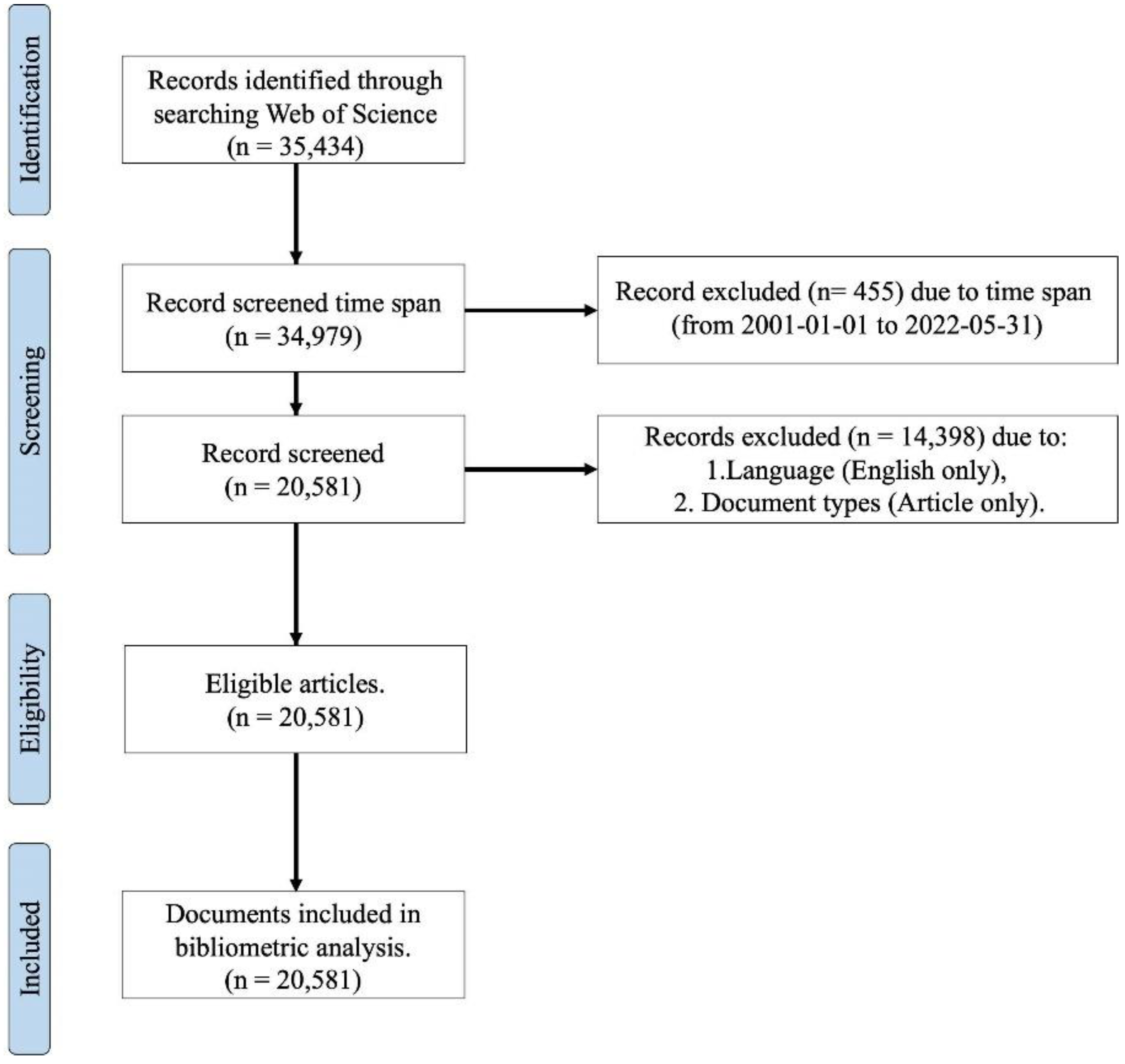

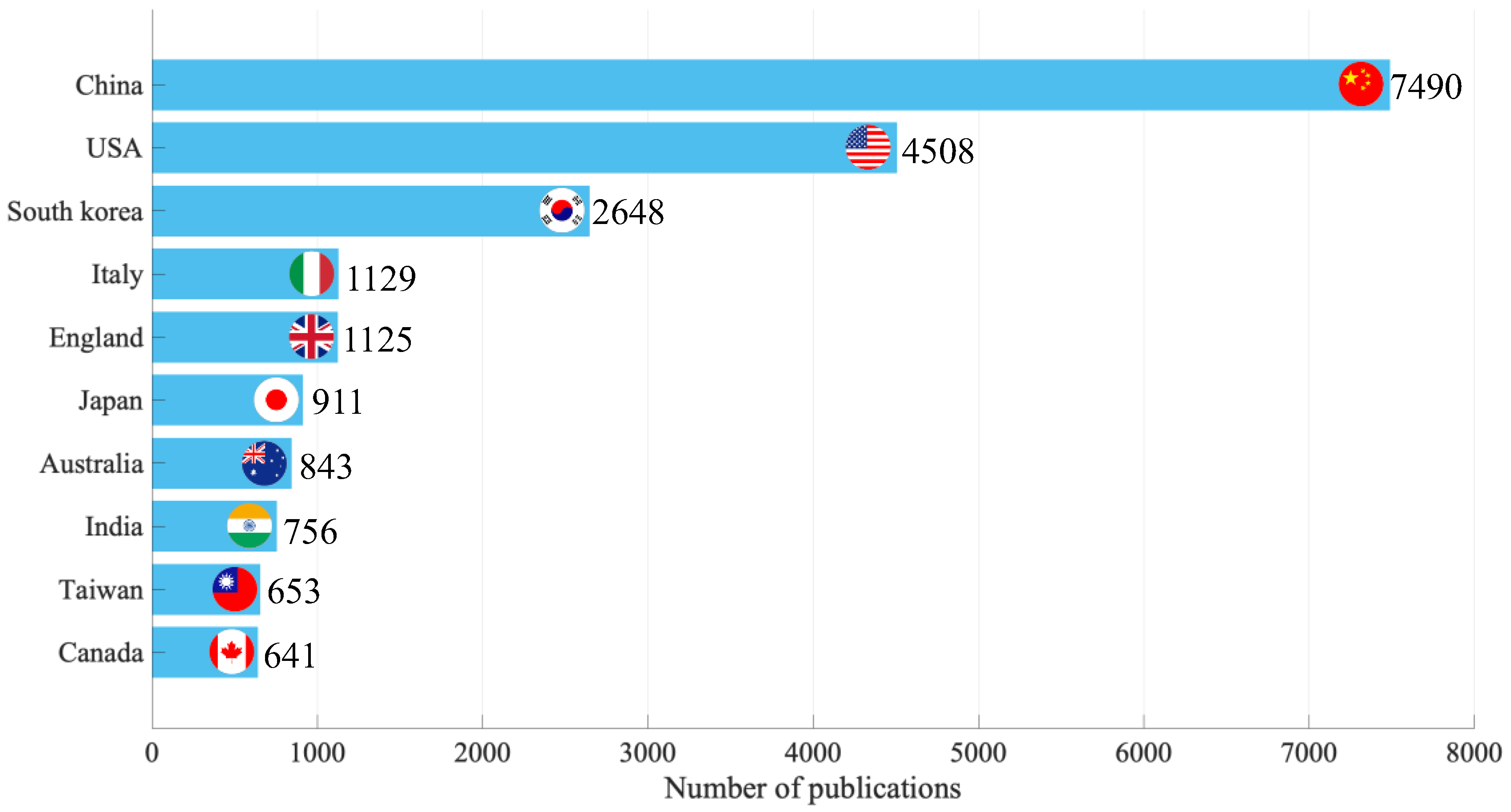

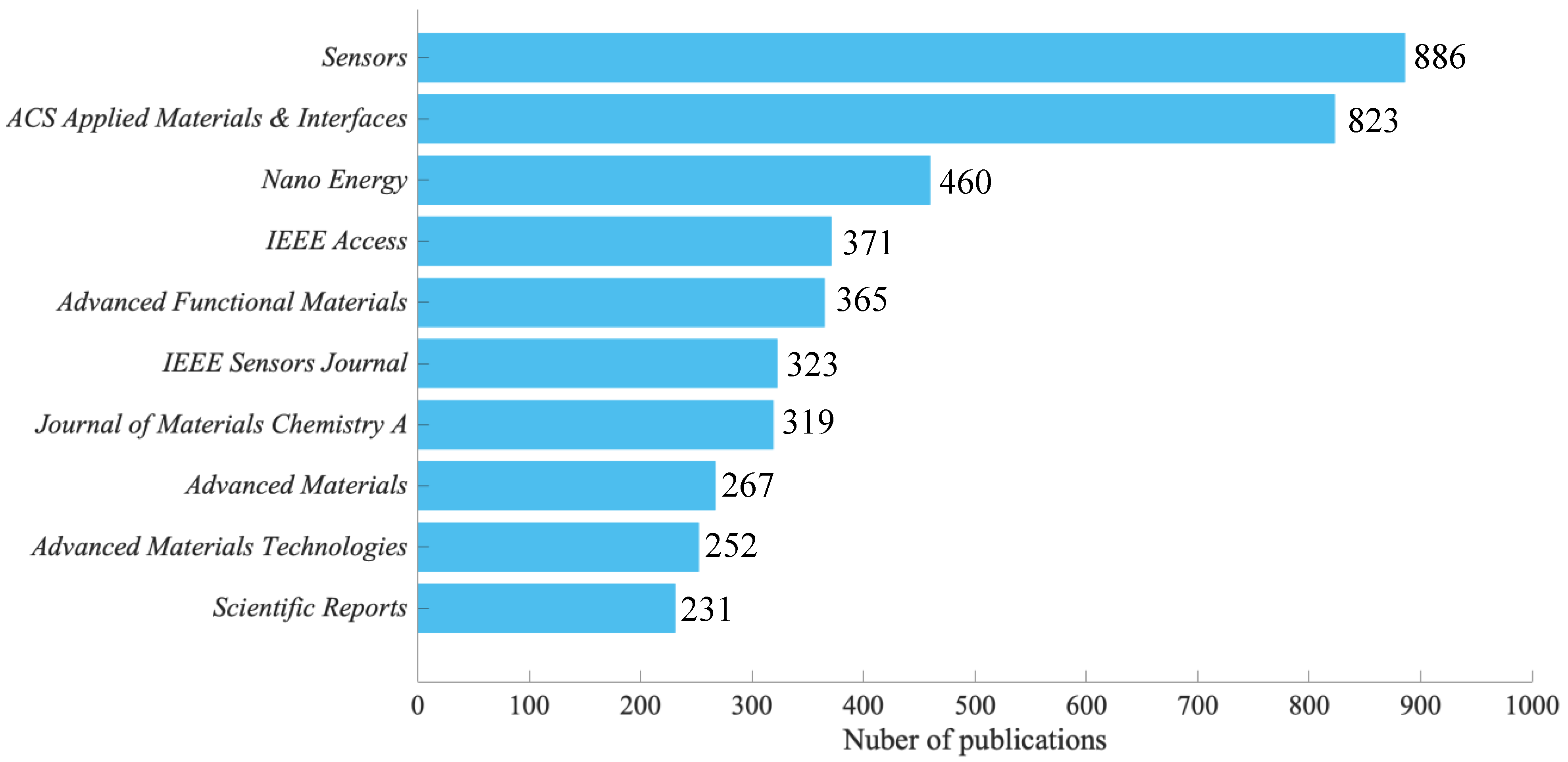
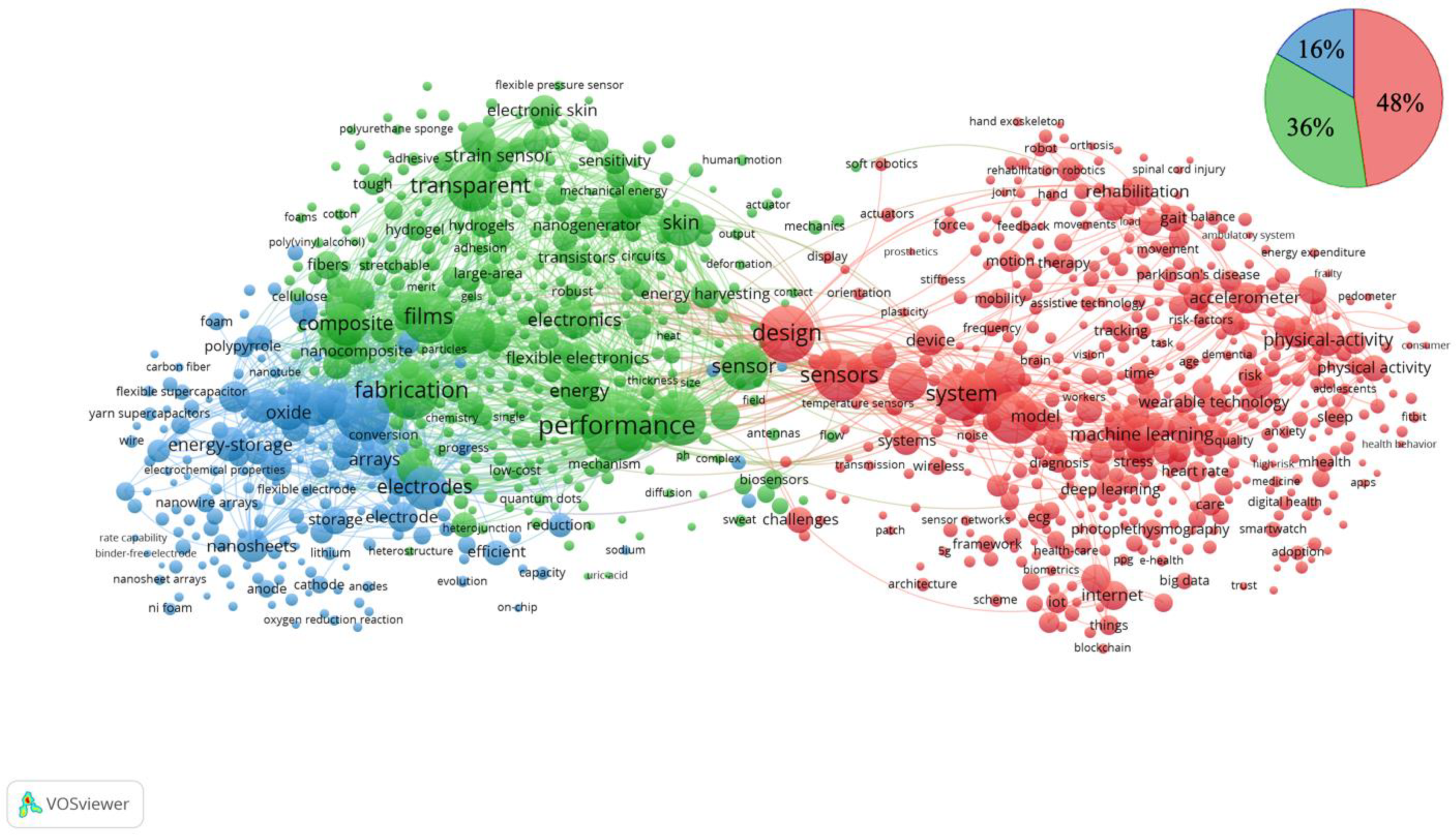


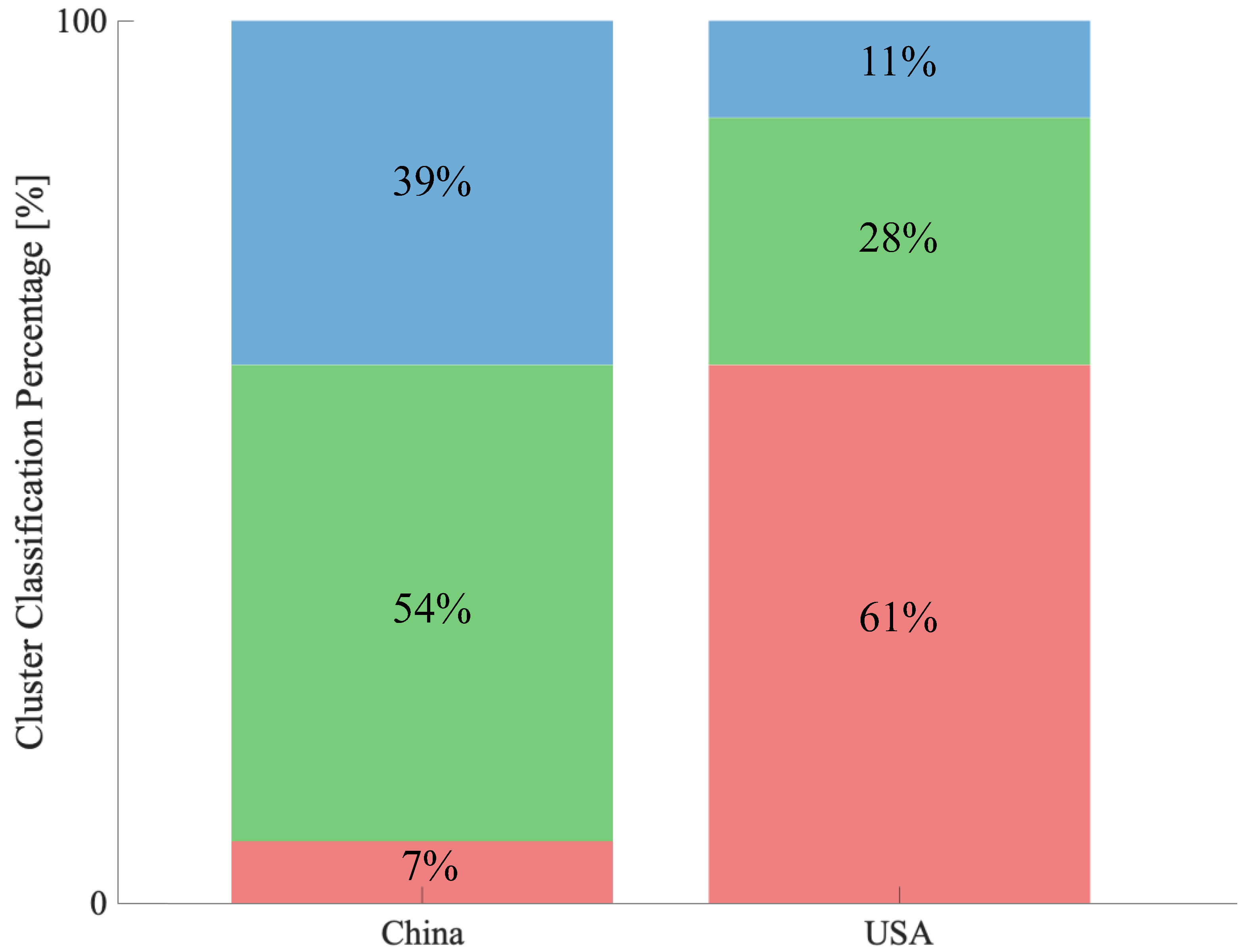
| Rank | Cluster 1 | Cluster 2 | Cluster 3 | |||
|---|---|---|---|---|---|---|
| Keyword | Weight | Keyword | Weight | Keyword | Weight | |
| 1 | Design | 849 | Performance | 889 | Electrodes | 617 |
| 2 | Sensors | 815 | Devices | 794 | Graphene | 608 |
| 3 | Wearable devices | 798 | Sensor | 754 | High-performance | 536 |
| 4 | Wearable device | 754 | Fabrication | 653 | Flexible | 478 |
| 5 | System | 736 | Films | 589 | Oxide | 457 |
| 6 | Wearable | 728 | Skin | 587 | Arrays | 452 |
| 7 | Wearable sensors | 622 | Energy | 583 | Electrode | 442 |
| 8 | Behavior | 607 | Wearable electronics | 577 | Supercapacitors | 435 |
| 9 | Device | 595 | Pressure | 556 | Paper | 426 |
| 10 | Health | 515 | Electronics | 546 | Carbon | 404 |
| 11 | Systems | 512 | Transparent | 541 | Reduction | 404 |
| 12 | Model | 501 | Composite | 540 | Fiber | 402 |
| 13 | Technology | 497 | Carbon nanotubes | 520 | Reduced graphene oxide | 398 |
| 14 | Wearables | 469 | Nanoparticles | 514 | Nanowires | 392 |
| 15 | Machine learning | 468 | Flexible electronics | 493 | Supercapacitor | 385 |
| 16 | Challenges | 463 | Composites | 492 | Energy-storage | 384 |
| 17 | Wearable sensor | 445 | Stability | 488 | Nanosheets | 373 |
| 18 | Reliability | 443 | Temperature | 482 | Efficient | 372 |
| 19 | Monitoring | 431 | Film | 478 | Textiles | 365 |
| 20 | Management | 397 | Networks | 474 | Nanotubes | 362 |
| 21 | Wearable technology | 397 | Nanocomposites | 469 | Storage | 358 |
| 22 | Classification | 394 | Network | 439 | Polyaniline | 349 |
| 23 | Waling | 394 | Stain sensor | 431 | Nanostructures | 342 |
| 24 | Rehabilitation | 377 | Stain | 429 | Batteries | 322 |
| 25 | Physical-activity | 376 | Polymer | 423 | Flexibility | 312 |
| 26 | Recognition | 373 | Graphene oxide | 420 | Hybrid | 305 |
| 27 | Biomedical monitoring | 369 | Conductivity | 404 | Polypyrrole | 302 |
| 28 | Disease | 362 | Stain sensors | 404 | Conversion | 297 |
| 29 | Internet | 361 | Fibers | 402 | Energy storage | 294 |
| 30 | Accelerometer | 360 | Triboelectric nanogenerator | 400 | Capacitance | 293 |
Publisher’s Note: MDPI stays neutral with regard to jurisdictional claims in published maps and institutional affiliations. |
© 2022 by the authors. Licensee MDPI, Basel, Switzerland. This article is an open access article distributed under the terms and conditions of the Creative Commons Attribution (CC BY) license (https://creativecommons.org/licenses/by/4.0/).
Share and Cite
Kageyama, I.; Kurata, K.; Miyashita, S.; Lim, Y.; Sengoku, S.; Kodama, K. A Bibliometric Analysis of Wearable Device Research Trends 2001–2022—A Study on the Reversal of Number of Publications and Research Trends in China and the USA. Int. J. Environ. Res. Public Health 2022, 19, 16427. https://doi.org/10.3390/ijerph192416427
Kageyama I, Kurata K, Miyashita S, Lim Y, Sengoku S, Kodama K. A Bibliometric Analysis of Wearable Device Research Trends 2001–2022—A Study on the Reversal of Number of Publications and Research Trends in China and the USA. International Journal of Environmental Research and Public Health. 2022; 19(24):16427. https://doi.org/10.3390/ijerph192416427
Chicago/Turabian StyleKageyama, Itsuki, Karin Kurata, Shuto Miyashita, Yeongjoo Lim, Shintaro Sengoku, and Kota Kodama. 2022. "A Bibliometric Analysis of Wearable Device Research Trends 2001–2022—A Study on the Reversal of Number of Publications and Research Trends in China and the USA" International Journal of Environmental Research and Public Health 19, no. 24: 16427. https://doi.org/10.3390/ijerph192416427
APA StyleKageyama, I., Kurata, K., Miyashita, S., Lim, Y., Sengoku, S., & Kodama, K. (2022). A Bibliometric Analysis of Wearable Device Research Trends 2001–2022—A Study on the Reversal of Number of Publications and Research Trends in China and the USA. International Journal of Environmental Research and Public Health, 19(24), 16427. https://doi.org/10.3390/ijerph192416427








